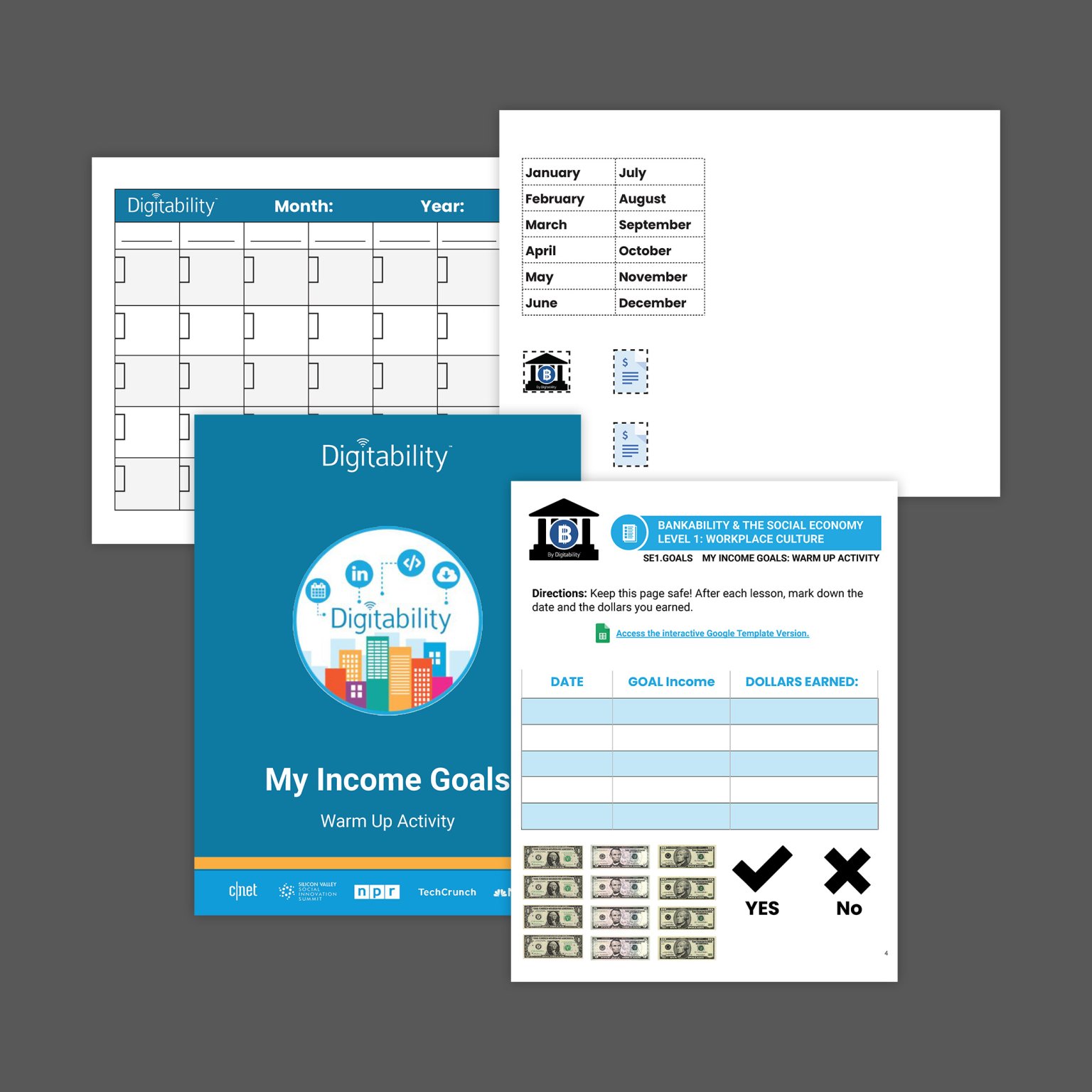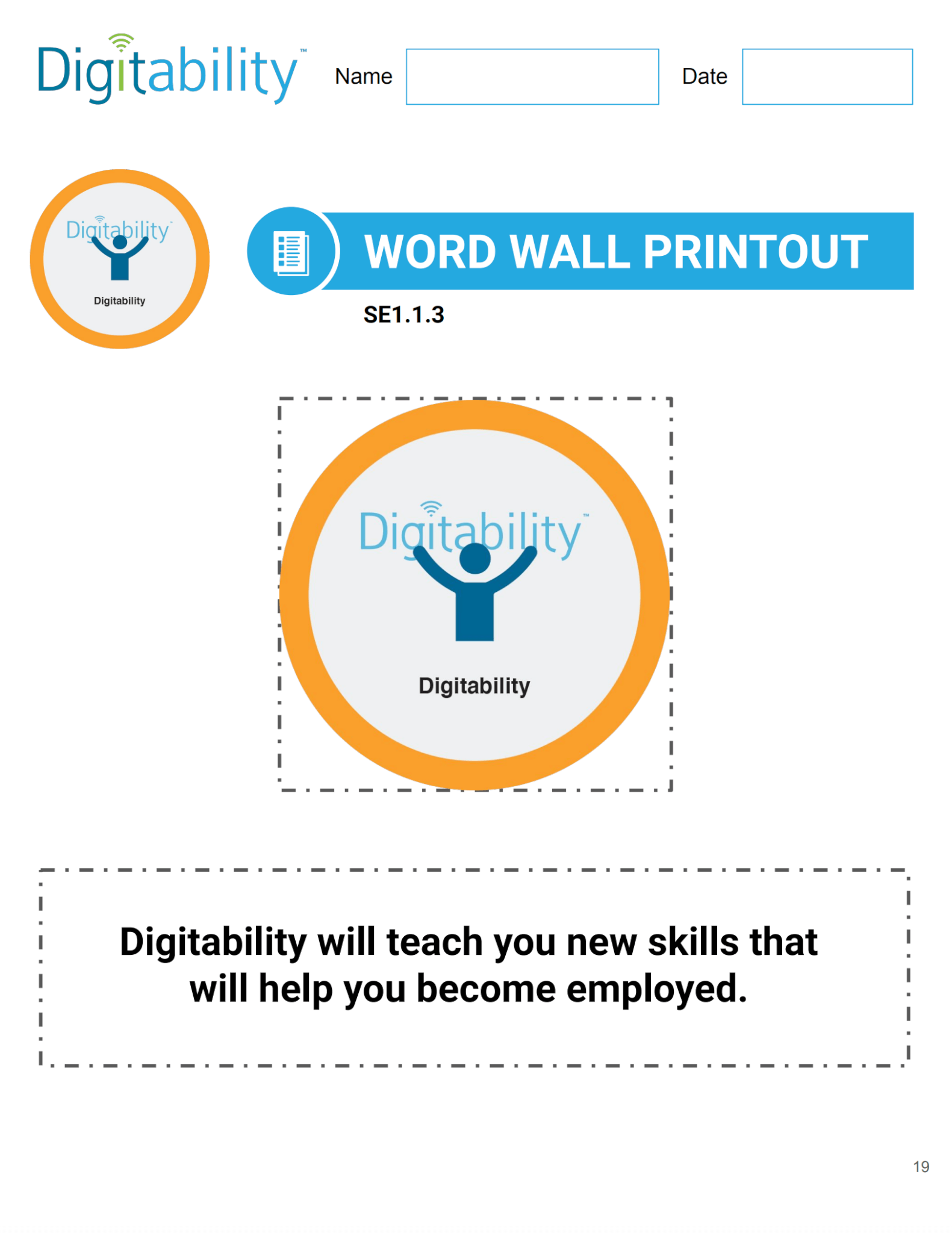Modifying Instruction During the Informal Assessment

No Two Students are the Same; Neither are their IEP Goals
Each student requires something different when it comes to their list of IEP goals. Every day teachers are charged with finding ways to engage, support, motivate and differentiate for each of their students.
Digitability has organized strategies for streamline evidence-based practices for any given classroom with a wide-range of student needs including varying cognitive abilities, expressive and receptive language, self-regulation skills, and age-appropriate behavior. It’s a tall order for life skills teachers to manage.
Get Your FREE Quote Today!
Overview of the Informal Assessment
Teachers use differentiation throughout the Informal Assessment to assess comprehension from the lesson video and include all students.
Goals for Financial Literacy and Workplace Behavior
The first part of the Informal Assessment asks students to recall the key concepts and definition from the lesson video. The goal of the Informal Assessment is to strengthen students’ auditory processing, time on task attendance, and comprehension by asking them to recall the key concepts from the lesson video. It is important that students use the specific language from the video. The Supplemental Materials section of each lesson plan includes differentiated supports to allow all students to be included in the informal assessment. One of the leveled resources is Image Exchange Cards. Each lesson plan also includes Yes/No Cards. Teachers can reframe questions to be in a yes or no format, rather than open-ended, to give students the opportunity to respond using the Yes/No Cards. The visual supports are designed to help students with limited expressive and receptive language and to ensure that every student is able to be meaningfully included in the lesson, regardless of their ability level.
In the next part of the Informal Assessment, teachers ask students additional questions from the video, such as "Can you view the same website from your home and classroom?"
Teachers select the most appropriate leveled resource for each individual student based on student needs. The level of differentiated resources may vary from student to student. Not all students in a class may be using the same leveled resources. The differentiated resources should be used to decrease assistance over time.
Meet the Student Personas
Note: The following personas are meant to illustrate a range of cognitive, communicative and behavioral needs for a wide-range of learning styles. These personas were created to help teachers identify the characteristics and associated strategies for their students needs.

Advanced Tier 1 Student: Drew can read, write, and comprehend paragraphs. Academically, he is one year below grade level. He is reinforced by getting time to use his phone during school. Drew has low motivation to complete assignments. He has difficulty with self-regulation and responsible decision making. He also has difficulty with impulse control. Drew is charismatic and his peers are drawn to him, giving him the potential to be a leader.

Tier 1 Student: Marcus can speak in 2-3 sentences and is able to read and comprehend paragraphs. He is reinforced by watching videos on Youtube. Marcus’ behaviors that impede learning include interrupting and complaining. He consistently is helpful with other students in the class and is a strong problem solver.

Tier 2 Student: Abbey can speak in 4-5 word utterances, and she is able to read with little comprehension. Abbey is reinforced by listening to music. She has some behaviors that interfere with learning, such as making off topic comments and teasing others. Abbey tends to perseverate on fairies and princesses, which contributes to her off topic comments. However, Abbey is an active participant in lessons and frequently shares with her peers.

Tier 3 Student: Jonathan is primarily nonverbal, he uses a communication device inconsistently, and knows some signs. He is not yet reading and has limited listening comprehension. Jonathan is reinforced by playing computer games. He demonstrates behaviors that interfere with learning, such as aggressive behavior and not following directions. However, Jonathan consistently greets others and likes to participate in lessons.
Strategies for an Advanced Tier 1 Student

Advanced Tier 1 Student:
Functional Academics: Can read, write, and comprehend paragraphs; Academically, he is one year below grade level.
Language: Age-appropriate
Reinforcers: Time to use his phone during school
Behavior: Low motivation to complete assignments. Difficulty with self-regulation and difficulty with impulse control.
Strengths: Charismatic and his peers are drawn to him, giving him the potential to be a leader.
During the Informal Assessment: The teacher will ask “For a Participation Dollar, what did the video say is the definition of internet?” Given Drew’s impulsive behavior, he may engage in attention seeking behavior by calling out instead of raising his hand. He yells out "A network!"
Strategies for Addressing Calling Out
- Drew is engaging in calling out due to his low impulse control. The teacher can redirect him by addressing him directly or by using Positive Narration. In both cases, Drew should be reminded of the reinforcement contingency.
- "Drew, to earn Participation Dollars you need to raise your hand to answer a question. Let's try again."
- Alternatively, the teacher can use Positive Narration and draw attention to a student who is exhibiting the expected behavior of raising their hand. “Let's see. Marcus has his hand up and is ready to share the definition and earn a Participation Dollar."
- After reinforcing Marcus for raising his hand and sharing the definition, the teacher can provide another opportunity for Drew to engage while reminding him that his participation provides him with rewards. "Marcus said the internet is a network that connects people. Nice work participating and earning a Participation Dollar! Who else would like to share and earn a Participation Dollar toward buying rewards?”
- The teacher can address Drew more directly to engage him in the activity. "Marcus is earning a lot of dollars today - he will be able to buy something fun later today! Same with Abbey. Drew, would you like to earn more dollars so that you can buy something fun today too?”
- The teacher can also prompt Drew toward a supplemental resource and their physical presence to engage Drew in this activity, creating an opportunity to provide positive reinforcement with some support. The teacher can direct Drew toward the word wall that includes the definition and picture of the key vocabulary terms. "Drew, for a Participation Dollar, can you read me the definition of our vocabulary term from our word wall?”
- The teacher can also direct Drew toward sentence starters to prompt him to give explicit answers to the informal assessment questions.
- Any time Drew participates, the teacher should provide immediate feedback using the embedded Digitability language formulas.
repeat the answer + describe the behavior + deliver consequence
"Drew said he earned $10 yesterday, great job earning a Participation Dollar!"
- In Level 2 of Digitability's Workplace Behavior Unit, students will identify and practice both the behaviors that will support their success in the workplace, as well as those behaviors that can be perceived as problematic. In these lesson plans, Digitability will explicitly explain how complaining impacts the workplace and depict strategies for developing self-regulation skills and a self-advocacy plan. In this level of Digitability, the teacher can utilize the Social Economy to assign a $1 fee for complaining to help Drew analyze the frequency of this behavior and strengthen his strategies for self-regulation. To learn more, contact our team

- What is an Extinction Burst? It is important to understand that with some interventions the behaviors may seem to increase in frequency, intensity or duration before they begin to decrease. This is called an extinction burst. Evidence-based practices embedded in Digitability's Social Economy are tools that should be used consistently in order to be effective. It won't be a one-and-done solution!
Strategies for a Tier 1 Student

Tier 1 Student:
Functional Academics: Can read and comprehend paragraphs
Language: Can speak in 2-3 sentences
Reinforcers: Watching videos on Youtube
Behavior: Interrupting and Complaining
Strengths: Consistently helpful with other students, strong problem solver
During the Informal Assessment: The teacher will ask “For a Participation Dollar, who can tell me what the video said the internet is?” When Marcus is called on to answer, he may complain and say "I don't know! I don't want to do this!"
Strategies for Addressing Complaining
- The behavior of complaining can serve as both attention seeking and task avoidance. The teacher should be sure to follow through with the demand while paying little attention to his complaints. “Marcus, think back to the video. What did it say the definition of the internet is?"

Gesture Prompt: the teacher can point to the definition of the internet that is posted on the word wall or on the google slides template for the lesson

Verbal Prompt: The teacher could start the sentence for him by saying “the internet is a computer network that…” Marcus still may give only a partial answer, such as “connects.” The teacher will have to extend their verbal prompting here. For example, “Good, it connects. Who does it connect?... Where are the people that it connects?”
- Another strategy that the teacher can use is Positive Narration. The teacher could say “Drew looked at the Word Wall to read the definition. He answered the question when he was asked and earned a Participation Dollar! Who else can use their resources to share the definition of the internet?”
- The teacher can also direct Marcus toward sentence starters to prompt him to give explicit answers to the informal assessment questions.
- After using positive narration and prompting, Marcus provides his answer. Whenever Marcus answers questions while demonstrating appropriate behavior and without complaining, the teacher should provide immediate feedback using the embedded Digitability language formulas.
repeat the answer + describe the behavior + deliver consequence.
This may look like “Marcus said the internet is a network that connects people, great job earning a Participation Dollar!"
- In Level 2 of Digitability's Workplace Behavior Unit, students will identify and practice more behaviors in the workplace that will support their success in the workplace as well as those behaviors that can be perceived as problematic. In these lesson plans, Digitability will explicitly explain how complaining impacts the workplace and strategies for developing self-regulation skills and self-advocacy plans for the workplace. To learn more, contact our team.
Strategies for a Tier 2 Student

Tier 2 Student:
Functional Academics: Can read with little comprehension, some writing skills, low IQ
Language: Speaks in 4-5 word utterances
Reinforcers: Listening to music
Behavior: Making off-topic comments due to perseverating on fairies and princesses, teasing others
Strengths: Actively participates in lessons, frequently shares with peers
During the Informal Assessment:. The teacher will ask “For a Participation Dollar, what did the video say the definition of the internet is?” Abbey may be exhibiting off-task behavior and drawing pictures of fairies instead of attending to the lesson. The teacher will need to redirect her and prompt her to the correct response.
Strategies for Addressing Off-Task Behavior
- Abbey is off-task and not attending to the informal assessment question. The teacher will need to redirect her back to the task. To do this, the teacher should remind her of the reinforcement contingency and the expected behaviors. "Abbey, make sure you are focused and listening so that you can earn dollars toward buying rewards! For a Participation Dollar, what did the video say the definition of the internet is?"

The teacher can redirect Abbey back to task by providing prompts to her. A visual prompt could be used by showing Abbey the Image Exchange Cards for the Informal Assessment. These can include one correct response and one to two distractor responses.

A gestural prompt could be used by the teacher pointing or motioning toward the correct Image Exchange Card.

A positional prompt could be used by placing the correct answer closer to Abbey to help her make the correct selection.
- If needed, a model prompt could be used by the teacher touching the correct answer card and verbally modeling the correct definition. If Abbey has trouble providing an answer that uses the language from the video, the teacher can replay that part of the video as a model for Abbey for how to use the specific language.
- When Abbey answers provides the correct response, the teacher will use the language formula: repeat the answer + describe the behavior + deliver consequence. This may look like "Abbey said the internet is a network, great job earning a Participation Dollar!"
- Any time Abbey provides responses with appropriate behavior, the teacher should provide immediate feedback using the embedded Digitability language formulas.
repeat the answer + describe the behavior + deliver consequence
"Abbey said the internet is a network, great job earning a Participation Dollar!"
- In Level 2 of Digitability's Workplace Behavior Unit, students will identify and practice more behaviors in the workplace that will support their success in the workplace as well as those behaviors that can be perceived as problematic. In these lesson plans, Digitability will explicitly explain how complaining impacts the workplace and strategies for developing self-regulation skills and self-advocacy plans for the workplace. To learn more, contact our team.
Strategies for a Tier 3 Student

Tier 3 Student:
Functional Academics: Not yet reading, limited listening comprehension, low IQ
Language: Primarily nonverbal, uses a communication device inconsistently, knows some signs
Reinforcers: Playing computer games
Behavior: Aggressive behavior, not following directions
Strengths: Consistently greets other, enjoys participating in lessons
During the Informal Assessment: The teacher will ask “For a Participation Dollar, who can tell me what the video said the definition of the internet is?” Jonathan should be given the opportunity to respond to the question using his communication device or using the Image Exchange Cards. The Image Exchange Cards for the Informal Assessment include one correct answer card and two distractor cards. The teacher should structure prompting to elicit a response from Jonathan.
Strategies for Prompting a Tier 3 Student
- Verbal, Gesture, Visual Prompts: While providing the Image Exchange Cards that correlate with the definition, the teacher can say "Jonathan, which card shows the internet" while simultaneously pointing to the corresponding answer card. If Jonathan needs more support, the Yes and No cards can be used and the teacher could ask "Jonathan, is the internet a network that connects people across the world?"

Positional Prompt: When asking the question, the teacher can display the Image Exchange Cards on Jonathan’s desk with the correct card closer to Jonathan, and the incorrect answers farther away.

Model Prompt: The teacher can model the process of selecting the correct answer by saying "I remember the video said that the internet is a network that connects people. This image shows a network connecting people across the world. This is the definition of the internet."

Physical Prompt: The teacher can take Jonathan’s hand and move it toward the correct answer card.
- After prompting Jonathan toward the correct answer, the teacher will use the language formula: repeat the answer + describe the behavior + deliver consequence. This may look like "Jonathan said the internet is a network that connects people, great job earning a Participation Dollar!"
- Any time Jonathan participates with appropriate behavior, the teacher should provide immediate feedback using the embedded Digitability language formulas.
repeat the answer + describe the behavior + deliver consequence
"Jonathan said the internet is a network that connects people, great job earning a Participation Dollar!"
- In Level 2 of Digitability's Workplace Behavior Unit, students will identify and practice more behaviors in the workplace that will support their success in the workplace as well as those behaviors that can be perceived as problematic. In these lesson plans, Digitability will explicitly explain how complaining impacts the workplace and strategies for developing self-regulation skills and self-advocacy plans for the workplace. To learn more, contact our team.
If you need additional resources or assistance in differentiation, reach out to your coach!







